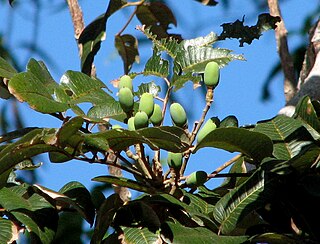
Canarium australianum, commonly known as scrub turpentine, is a species of tree in the family Burseraceae native to Australia and Papua New Guinea. Other common names include mango bark, carrot wood, parsnip wood, Melville Island white beech and brown cudgerie.

Acacia maitlandii, also known as Maitland's wattle, is a perennial tree native to Australia.

The flora of Western Australia comprises 10,842 published native vascular plant species and a further 1,030 unpublished species. They occur within 1,543 genera from 211 families; there are also 1,335 naturalised alien or invasive plant species more commonly known as weeds. There are an estimated 150,000 cryptogam species or nonvascular plants which include lichens, and fungi although only 1,786 species have been published, with 948 algae and 672 lichen the majority.
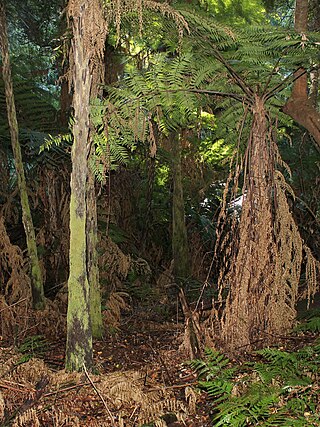
Sphaeropteris australis, synonyms Alsophila leichhardtiana and Cyathea leichhardtiana, the prickly tree fern, is a plant in the tree fern family, Cyatheaceae. It is native to eastern Australia. It is a common species found in moist situations, in and near rainforests.
Hollandaea is a small genus of plants in the family Proteaceae containing four species of Australian rainforest trees. All four species are endemic to restricted areas of the Wet Tropics of northeast Queensland.

Helicia ferruginea, commonly named hairy honeysuckle or rusty oak, is a species of rainforest trees, of eastern Australia, from the flowering plant family Proteaceae.
Hollandaea sayeriana, sometimes named Sayer's silky oak, is a small species of Australian rainforest trees in the plant family Proteaceae.

Erechtites glomeratus, common name New Zealand fireweed, or cutleaf burnweed, or fireweed or Cluster-headed fireweed, is a species of plant in the sunflower family. It is native to Australia and New Zealand, and also naturalized on the Pacific Coast of the United States.
Grevillea nematophylla, commonly known as water bush or silver-leaved water bush, is a species of flowering plant in the family Proteaceae and is endemic to Australia. It is shrub or small tree with simple or pinnatisect leaves, the leaves or lobes linear, and branched, cylindrical clusters of cream-coloured flowers.

Nymphoides crenata, commonly known as wavy marshwort, is an aquatic perennial herb of the family Menyanthaceae endemic to Australia, found in all mainland states and the Northern Territory

Kennedia lateritia, commonly known as Augusta kennedia, is a species of flowering plant in the family Fabaceae and is endemic to the south-west of Western Australia. It is a woody climber with twining stems, trifoliate leaves and orange-red and yellow flowers arranged in groups of up to twenty-four.
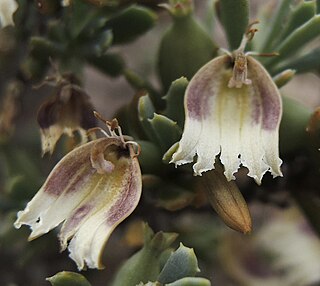
Scaevola collaris is a shrub in the family Goodeniaceae and its native range is five mainland states/territories of Australia: the Northern Territory, New South Wales, South Australia, Queensland and Western Australia.
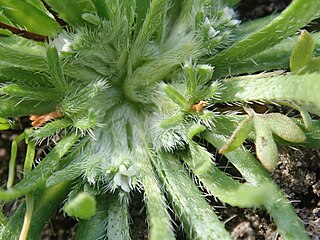
Plagiobothrys plurisepaleus is a species of flowering plant in the borage family. It is native to Australia, being found in all mainland states: New South Wales, Queensland, Victoria, South Australia, Western Australia and the Northern Territory, in moist areas in and around claypans.

Phebalium tuberculosum is a species of erect shrub that is endemic to Western Australia. It has glandular-warty and scaly branchlets and leaves and white flowers arranged in umbels of three or four with rust-coloured scales on the back of the petals.

Dicrastylis lewellinii is a species of plant within the genus, Dicrastylis, in the family Lamiaceae. It is found in Western Australia, the Northern Territory, New South Wales, Queensland and South Australia.
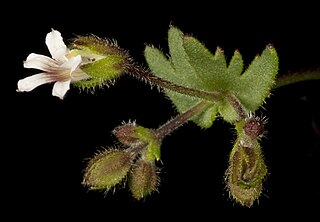
Goodenia cycnopotamica is a species of flowering plant in the Goodeniaceae family and is endemic to Australia, found in both South Australia and Western Australia. It is an annual herb with oblong to lance-shaped leaves and pink or lilac to white flowers.

Hybanthus floribundus is a plant in the Violaceae family, found in southern Western Australia, southern South Australia, Victoria and southern New South Wales.
Pomaderris grandis, commonly known as large pomaderris, is a species of flowering plant in the family Rhamnaceae and is endemic to a restricted part of the south-west of Western Australia. It is an erect shrub that typically grows to a height of 30–75 cm (12–30 in) and produces white flowers from July to October. It grows in rocky gullies on the slopes of Mount Manypeaks in the Esperance Plains biogeographic region of south-western Western Australia. The species was first formally described in 1862 by Ferdinand von Mueller in his Fragmenta Phytographiae Australiae. It is listed as "Priority Four" by the Government of Western Australia Department of Biodiversity, Conservation and Attractions, meaning that it is rare or near threatened.

Trichanthodium skirrophorum is a plant species in the Asteraceae family (daisies), first described by Otto Wilhelm Sonder and Ferdinand von Mueller in 1853.

Lepidium phlebopetalum, commonly known as veined peppercress, is a plant of the Brassicaceae family that is endemic to parts of Australia.



















